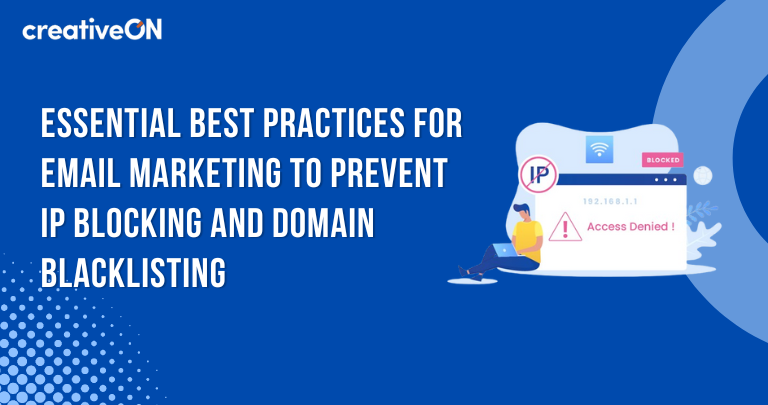In the world of email marketing, maintaining a positive reputation with email service providers (ESPs) is critical to ensuring that your emails land in your subscribers’ inboxes, not their spam folders. One misstep can lead to your domain or IP getting blacklisted, which can significantly harm your marketing efforts. Below, we’ll explore the best practices to protect your domain and IP while doing email marketing.
1. Use Double Opt-In for List Building
Why: Double opt-in ensures that subscribers explicitly agree to receive your emails, reducing the chance of spam complaints.
How: After someone signs up for your list, send a confirmation email asking them to verify their subscription. Only add them to your email list after they’ve confirmed. This extra step ensures you’re building a high-quality list of engaged subscribers.
2. Clean and Maintain Your Email List Regularly
Why: Outdated or inactive email addresses can lead to high bounce rates, triggering spam filters and harming your sender reputation.
How: Regularly remove invalid, bounced, or unengaged emails from your list. List-cleaning services like ZeroBounce or NeverBounce can help you maintain a healthy list. This practice reduces bounce rates and helps ensure your emails are reaching active inboxes.
3. Avoid Spammy Words and Phrases
Why: Spam filters are triggered by certain keywords like “Free,” “Buy Now,” or “100% Guaranteed,” which can hurt your deliverability.
How: Use more natural and less aggressive language in your subject lines and email copy. Focus on providing value rather than making over-the-top claims. By doing so, you’ll not only avoid spam filters but also improve your email’s engagement rate.
4. Ensure Proper Authentication (SPF, DKIM, DMARC)
Why: Authenticating your domain with SPF (Sender Policy Framework), DKIM (DomainKeys Identified Mail), and DMARC (Domain-based Message Authentication, Reporting, and Conformance) helps email providers verify that your emails are legitimate.
How: Set up these authentication protocols with your email service provider and hosting provider. Proper authentication boosts email deliverability and protects your domain from being spoofed by malicious senders.
5. Send Emails from a Dedicated IP (for Large Volumes)
Why: If you’re sending large volumes of emails, using a dedicated IP ensures that your domain’s reputation isn’t impacted by other users on shared IPs.
How: Arrange for a dedicated IP through your email service provider. Gradually warm up the IP by sending small batches of emails to your most engaged subscribers before scaling up to larger volumes.
6. Warm Up a New Domain or IP
Why: Sending large amounts of emails from a new domain or IP can trigger spam filters or cause deliverability issues.
How: Gradually increase your email volume over time to build a positive reputation with internet service providers (ISPs). Start by sending emails to your most engaged subscribers to build trust with ESPs before scaling up your campaigns.
7. Respect Unsubscribe Requests
Why: Failing to respect unsubscribe requests can result in spam complaints and damage your domain’s reputation.
How: Always include a clear and visible unsubscribe link in your emails. Ensure unsubscribe requests are honored immediately to avoid penalties and maintain trust with your audience.
8. Monitor Your Email Metrics (Spam Complaints, Bounces, etc.)
Why: High bounce rates or spam complaints can signal to ESPs that you’re sending unwanted emails, leading to domain or IP blacklisting.
How: Use analytics from your email service provider to monitor important metrics like bounce rates, spam complaints, and unsubscribe rates. Aim to keep your bounce rate below 2% and spam complaints under 0.1%. Regularly reviewing these metrics will help you identify and fix any issues before they affect your sender reputation.
9. Send Relevant and Engaging Content
Why: Sending irrelevant or poorly timed emails increases spam complaints and unsubscribe rates.
How: Segment your email list based on user behavior, preferences, or demographics. Sending personalized and relevant content not only keeps your subscribers engaged but also reduces the likelihood of complaints or unsubscribes.
10. Comply with Legal Requirements (CAN-SPAM, GDPR)
Why: Non-compliance with email marketing laws can result in hefty fines or getting blacklisted.
How: Make sure your emails include a physical mailing address and a clear unsubscribe option. Only send emails to individuals who have given explicit consent. If you’re targeting EU citizens or handling EU data, ensure that you comply with GDPR regulations for data privacy.
By following these best practices, you can protect your domain and IP reputation, improve deliverability, and ensure that your email marketing campaigns reach the inboxes of your subscribers. Staying compliant and focusing on high-quality, engaging content will help you achieve long-term success in your email marketing efforts.

